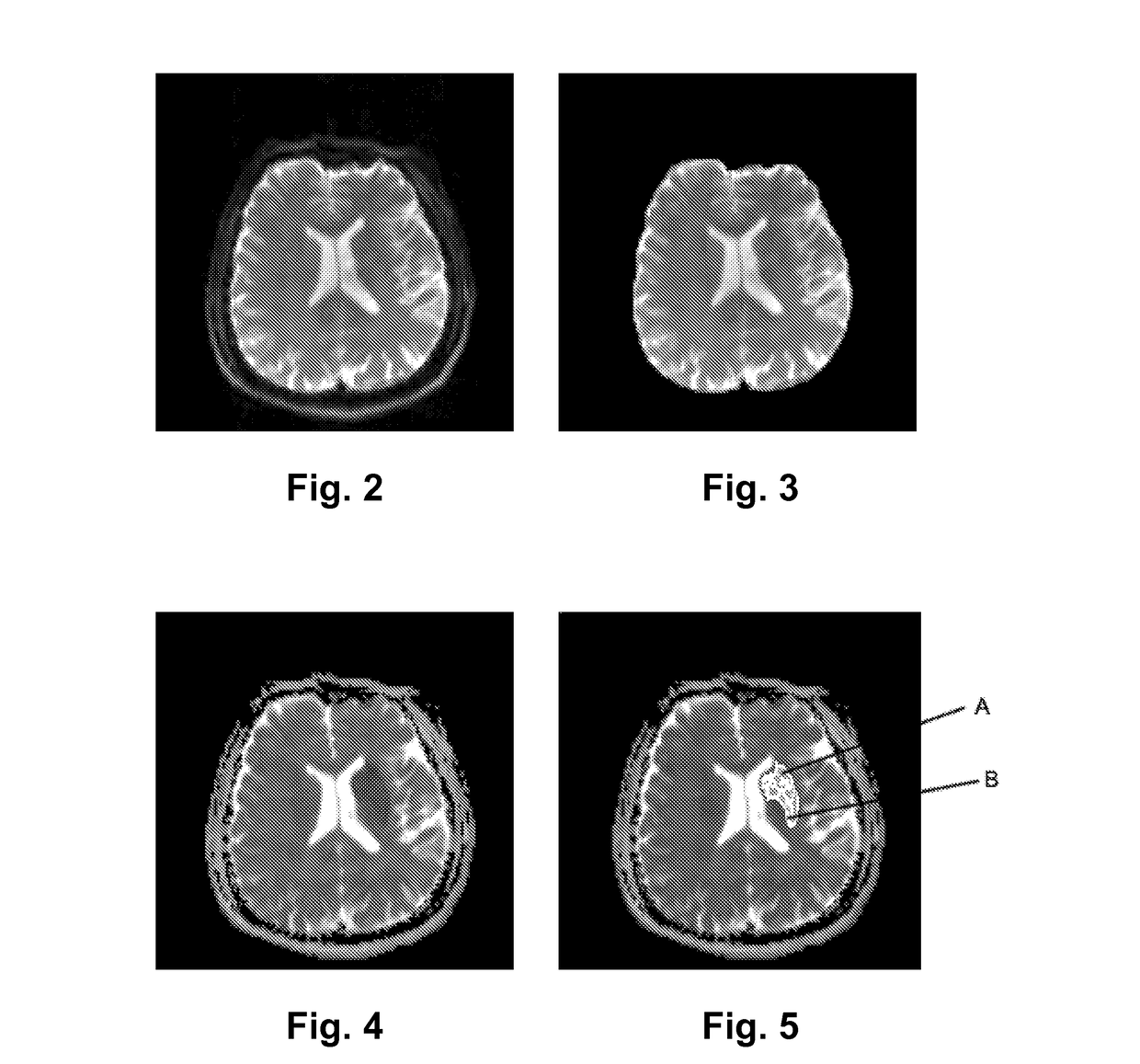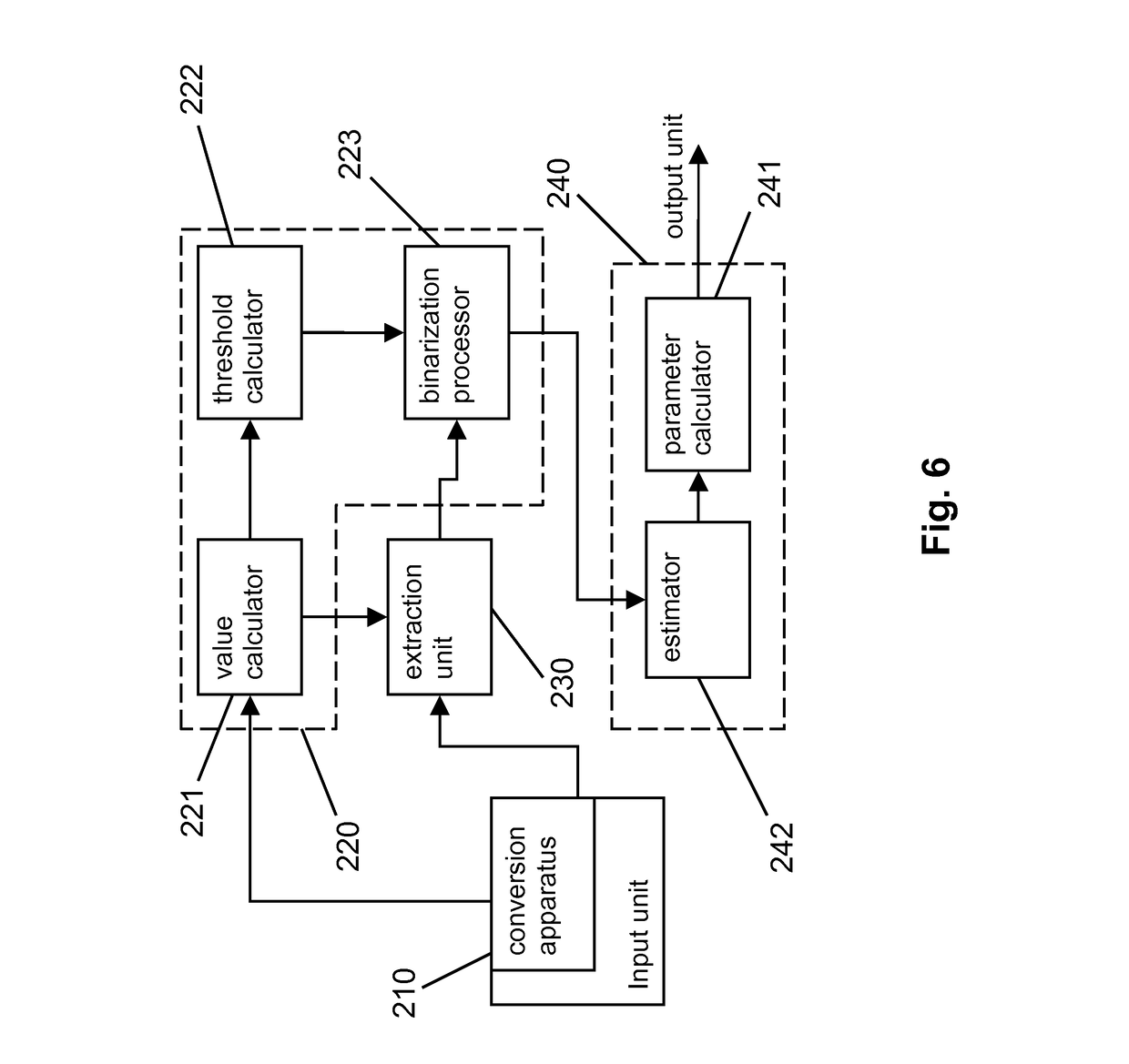Methods and devices for producing the parameters of the brain tissues and assessing data of the suitability for thrombolysis of a patient
a brain tissue and parameter technology, applied in the field of medical imaging technology, can solve the problems of cell death in minutes, severe ionic disruption and metabolic failure, and zones within flow-compromised territory, so as to save critical time, shorten imaging time, and reduce patient cost
- Summary
- Abstract
- Description
- Claims
- Application Information
AI Technical Summary
Benefits of technology
Problems solved by technology
Method used
Image
Examples
example 1
The Method for Producing the Parameters of the Brain Tissues of a Patient
[0035]The method of the present invention utilizes the Diffusion-Weighted Imaging (DWI) of a ischemic stroke patient, including two volumetric data form diffusion weighted imaging: (1) T2-weighted image (i.e., the DWI with the gradient factor b being 0) denoted as T2(x, y, z), and (2) the ADC image denoted as ADC(x, y, z)), both of which have the same voxel sizes, same coordinate systems, and the same coordinates correspond to the same physical positions, obtained when the patient is admitted to have the acute DWI scan.
[0036]Both T2(x, y, z) and ADC(x, y, z) are in 16-bits DICOM format. It is assumed that the voxel sizes in the X, Y, and Z directions are denoted as voxX, voxY, and voxZ, respectively with mm / voxel as their units. Here (x, y, z) are integer coordinates of voxels satisfying 0≦x≦xSize-1, 0≦y≦ySize-1, 0≦z≦zSize-1. The z coordinate is constant on axial, y on coronal, and x on sagittal slices.
[0037]A ...
example 2
The Medical Device Producing the Parameters of the Brain Tissues of a Patient, the Device Comprising
[0093]Based on the method described above, a medical device comprises at least an input unit 210 and a processing module. The input unit provides interface for inputting the DICOM data of the patients T2(x, y, z) and ADC(x, y, z), and the processing module to perform the processing described in steps 1 to 5.
[0094]The input unit 210 has a conversion apparatus converting the image from 16-bit data to 8-bit or 4-bit data, i.e. an apparatus implementing the step #1.
[0095]The processing module comprises an extraction unit 230 extracting a brain tissues image from the T2-weighted image, an image processing unit 220 achieving a core ADC threshold and a transition ADC threshold that could differentiate a core region and a transition region respectively and binarizing the ADC image through the transition ADC threshold according to the brain tissues image to achieve a binarized ADC image, and a...
example 3
The Method for Producing and Assessing Data of the Suitability for Thrombolysis of a Patient
[0101]The method of the present invention comprises a group of steps in which the first step to the five step are the same as example 1 and the sixth step to the seven step are as follows:
[0102]Step #6: Assessing if There Exist Ischemic Tissues to be Rescued
[0103]To assess if there exist ischemic tissues to be rescued is to see if the transition regions contain ischemic tissues to be rescued. This is achieved through training samples. A patient's data is used as one of the training samples if it meets one of the following criteria: 1) the patient shows substantial improvement after thrombolysis, which implies that this patient has ischemic tissues to be rescued and these tissues have been rescued through thrombolysis; 2) the patient symptoms are deteriorated after thrombolysis, which implies that this patient should not be handled with thrombolysis; and 3) those patients that show no mismatch...
PUM
 Login to View More
Login to View More Abstract
Description
Claims
Application Information
 Login to View More
Login to View More - R&D
- Intellectual Property
- Life Sciences
- Materials
- Tech Scout
- Unparalleled Data Quality
- Higher Quality Content
- 60% Fewer Hallucinations
Browse by: Latest US Patents, China's latest patents, Technical Efficacy Thesaurus, Application Domain, Technology Topic, Popular Technical Reports.
© 2025 PatSnap. All rights reserved.Legal|Privacy policy|Modern Slavery Act Transparency Statement|Sitemap|About US| Contact US: help@patsnap.com



